
Question Number 79538 by Pratah last updated on 26/Jan/20

Commented by john santu last updated on 26/Jan/20
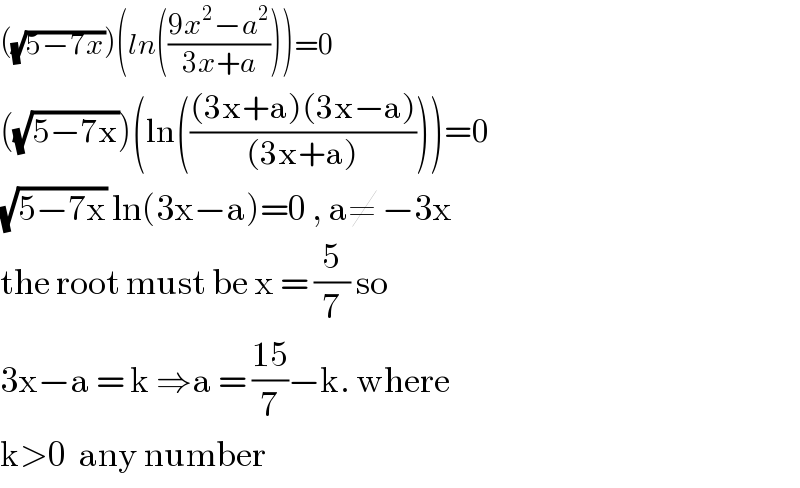
$$\left(\sqrt{\mathrm{5}−\mathrm{7}{x}}\right)\left({ln}\left(\frac{\mathrm{9}{x}^{\mathrm{2}} −{a}^{\mathrm{2}} }{\mathrm{3}{x}+{a}}\right)\right)=\mathrm{0} \\ $$$$\left(\sqrt{\mathrm{5}−\mathrm{7x}}\right)\left(\mathrm{ln}\left(\frac{\left(\mathrm{3x}+\mathrm{a}\right)\left(\mathrm{3x}−\mathrm{a}\right)}{\left(\mathrm{3x}+\mathrm{a}\right)}\right)\right)=\mathrm{0} \\ $$$$\sqrt{\mathrm{5}−\mathrm{7x}}\:\mathrm{ln}\left(\mathrm{3x}−\mathrm{a}\right)=\mathrm{0}\:,\:\mathrm{a}\neq\:−\mathrm{3x} \\ $$$$\mathrm{the}\:\mathrm{root}\:\mathrm{must}\:\mathrm{be}\:\mathrm{x}\:=\:\frac{\mathrm{5}}{\mathrm{7}}\:\mathrm{so} \\ $$$$\mathrm{3x}−\mathrm{a}\:=\:\mathrm{k}\:\Rightarrow\mathrm{a}\:=\:\frac{\mathrm{15}}{\mathrm{7}}−\mathrm{k}.\:\mathrm{where}\: \\ $$$$\mathrm{k}>\mathrm{0}\:\:\mathrm{any}\:\mathrm{number} \\ $$
Commented by Pratah last updated on 26/Jan/20

$$\mathrm{thanks} \\ $$
Commented by john santu last updated on 26/Jan/20

$${this}\:{answer}\:{right}? \\ $$
Commented by john santu last updated on 26/Jan/20

$$\mathrm{oo}\:\mathrm{yes}\:.\:\mathrm{the}\:\mathrm{equation}\:\mathrm{has}\:\mathrm{one}\:\mathrm{roots}.\: \\ $$$$\mathrm{i}\:\mathrm{correct}\:\mathrm{my}\:\mathrm{answer} \\ $$
Commented by john santu last updated on 26/Jan/20

$$\mathrm{sir}\:\mathrm{the}\:\mathrm{answer}\:\mathrm{is}\:\mathrm{2}\:\mathrm{possibilities}.\: \\ $$$$\mathrm{the}\:\mathrm{roots}\:\mathrm{can}\:\mathrm{form}\:\sqrt{\mathrm{5}−\mathrm{7x}}\:\mathrm{and}\:\mathrm{can}\:\mathrm{be}\: \\ $$$$\mathrm{from}\:\mathrm{ln}\left(\frac{\mathrm{9x}^{\mathrm{2}} −\mathrm{a}^{\mathrm{2}} }{\mathrm{3x}+\mathrm{a}}\right) \\ $$
Commented by john santu last updated on 26/Jan/20

$$\mathrm{when}\:\mathrm{we}\:\mathrm{take}\:\mathrm{the}\:\mathrm{root}\:\mathrm{out}\: \\ $$$$\mathrm{of}\:\mathrm{shape}\:\sqrt{\mathrm{5}−\mathrm{7x}}\:,\:\mathrm{so}\:\mathrm{must}\:\mathrm{be}\: \\ $$$$\mathrm{a}\neq\:\frac{\mathrm{8}}{\mathrm{7}}\:\wedge\mathrm{a}\neq−\frac{\mathrm{15}}{\mathrm{7}} \\ $$
Commented by jagoll last updated on 26/Jan/20

$$\mathrm{please}\:\mathrm{post}\:\mathrm{your}\:\mathrm{solution}\:\mathrm{sir} \\ $$
Commented by mr W last updated on 26/Jan/20

$${to}\:{jagoll}\:{sir}: \\ $$$${are}\:{you}\:{talking}\:{to}\:{Pratah}\:{sir}?\:{then} \\ $$$${you}\:{can}\:{directly}\:{talk}\:{to}\:{a}\:{wall}.\:{a}\:{wall} \\ $$$${may}\:{give}\:{yoy}\:{an}\:{echo}\:{back},\:{but}\:{he}\:{not}. \\ $$
Commented by jagoll last updated on 26/Jan/20

$$\mathrm{to}\:\mathrm{Mr}\:\mathrm{W}\:\mathrm{sir}.\:\mathrm{i}\:\mathrm{need}\:\mathrm{your}\:\mathrm{explain} \\ $$
Commented by jagoll last updated on 26/Jan/20

$$\mathrm{i}'\mathrm{m}\:\mathrm{interested}\:\mathrm{the}\:\mathrm{quation} \\ $$
Commented by john santu last updated on 26/Jan/20

$$\mathrm{yes}\:\mathrm{sir},\:\mathrm{i}\:\mathrm{wonder}\:\mathrm{if}\:\mathrm{this}\:\mathrm{is}\:\mathrm{an}\:\mathrm{ambiguous}? \\ $$
Commented by john santu last updated on 26/Jan/20

$$\mathrm{how}\:\mathrm{to}\:\mathrm{get}\:<−\frac{\mathrm{1}}{\mathrm{2}}\:\mathrm{sir}.\:\: \\ $$$$\mathrm{because}\:\bigtriangleup=\left(\mathrm{2a}+\mathrm{1}\right)^{\mathrm{2}} <\mathrm{0}\: \\ $$$$\mathrm{we}\:\mathrm{get}\:\mathrm{a}\:\notin\mathbb{R} \\ $$
Commented by john santu last updated on 26/Jan/20

$$\mathrm{thank}\:\mathrm{you}\:\mathrm{sir} \\ $$
Answered by mr W last updated on 26/Jan/20
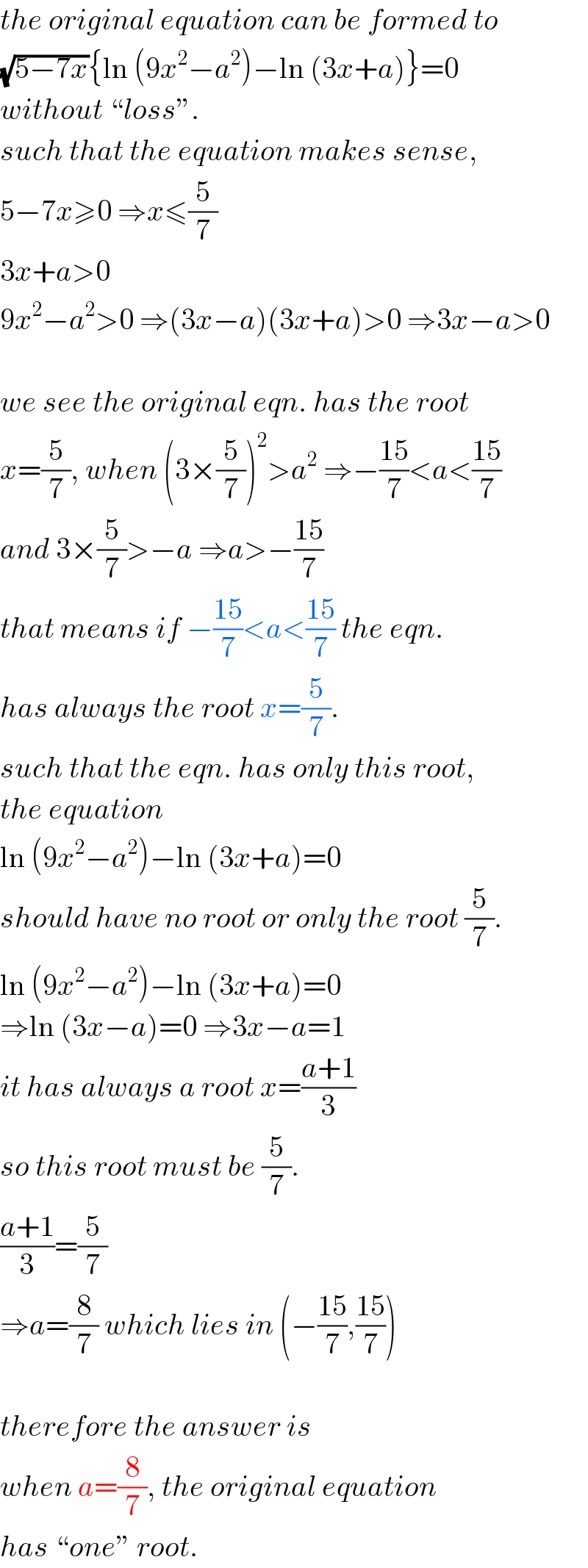
$${the}\:{original}\:{equation}\:{can}\:{be}\:{formed}\:{to} \\ $$$$\sqrt{\mathrm{5}−\mathrm{7}{x}}\left\{\mathrm{ln}\:\left(\mathrm{9}{x}^{\mathrm{2}} −{a}^{\mathrm{2}} \right)−\mathrm{ln}\:\left(\mathrm{3}{x}+{a}\right)\right\}=\mathrm{0} \\ $$$${without}\:``{loss}''. \\ $$$${such}\:{that}\:{the}\:{equation}\:{makes}\:{sense}, \\ $$$$\mathrm{5}−\mathrm{7}{x}\geqslant\mathrm{0}\:\Rightarrow{x}\leqslant\frac{\mathrm{5}}{\mathrm{7}} \\ $$$$\mathrm{3}{x}+{a}>\mathrm{0}\: \\ $$$$\mathrm{9}{x}^{\mathrm{2}} −{a}^{\mathrm{2}} >\mathrm{0}\:\Rightarrow\left(\mathrm{3}{x}−{a}\right)\left(\mathrm{3}{x}+{a}\right)>\mathrm{0}\:\Rightarrow\mathrm{3}{x}−{a}>\mathrm{0} \\ $$$$ \\ $$$${we}\:{see}\:{the}\:{original}\:{eqn}.\:{has}\:{the}\:{root} \\ $$$${x}=\frac{\mathrm{5}}{\mathrm{7}},\:{when}\:\left(\mathrm{3}×\frac{\mathrm{5}}{\mathrm{7}}\right)^{\mathrm{2}} >{a}^{\mathrm{2}} \:\Rightarrow−\frac{\mathrm{15}}{\mathrm{7}}<{a}<\frac{\mathrm{15}}{\mathrm{7}} \\ $$$${and}\:\mathrm{3}×\frac{\mathrm{5}}{\mathrm{7}}>−{a}\:\Rightarrow{a}>−\frac{\mathrm{15}}{\mathrm{7}} \\ $$$${that}\:{means}\:{if}\:−\frac{\mathrm{15}}{\mathrm{7}}<{a}<\frac{\mathrm{15}}{\mathrm{7}}\:{the}\:{eqn}. \\ $$$${has}\:{always}\:{the}\:{root}\:{x}=\frac{\mathrm{5}}{\mathrm{7}}. \\ $$$${such}\:{that}\:{the}\:{eqn}.\:{has}\:{only}\:{this}\:{root}, \\ $$$${the}\:{equation} \\ $$$$\mathrm{ln}\:\left(\mathrm{9}{x}^{\mathrm{2}} −{a}^{\mathrm{2}} \right)−\mathrm{ln}\:\left(\mathrm{3}{x}+{a}\right)=\mathrm{0} \\ $$$${should}\:{have}\:{no}\:{root}\:{or}\:{only}\:{the}\:{root}\:\frac{\mathrm{5}}{\mathrm{7}}. \\ $$$$\mathrm{ln}\:\left(\mathrm{9}{x}^{\mathrm{2}} −{a}^{\mathrm{2}} \right)−\mathrm{ln}\:\left(\mathrm{3}{x}+{a}\right)=\mathrm{0} \\ $$$$\Rightarrow\mathrm{ln}\:\left(\mathrm{3}{x}−{a}\right)=\mathrm{0}\:\Rightarrow\mathrm{3}{x}−{a}=\mathrm{1} \\ $$$${it}\:{has}\:{always}\:{a}\:{root}\:{x}=\frac{{a}+\mathrm{1}}{\mathrm{3}} \\ $$$${so}\:{this}\:{root}\:{must}\:{be}\:\frac{\mathrm{5}}{\mathrm{7}}. \\ $$$$\frac{{a}+\mathrm{1}}{\mathrm{3}}=\frac{\mathrm{5}}{\mathrm{7}} \\ $$$$\Rightarrow{a}=\frac{\mathrm{8}}{\mathrm{7}}\:{which}\:{lies}\:{in}\:\left(−\frac{\mathrm{15}}{\mathrm{7}},\frac{\mathrm{15}}{\mathrm{7}}\right) \\ $$$$ \\ $$$${therefore}\:{the}\:{answer}\:{is} \\ $$$${when}\:{a}=\frac{\mathrm{8}}{\mathrm{7}},\:{the}\:{original}\:{equation} \\ $$$${has}\:``{one}''\:{root}. \\ $$
Commented by mr W last updated on 26/Jan/20
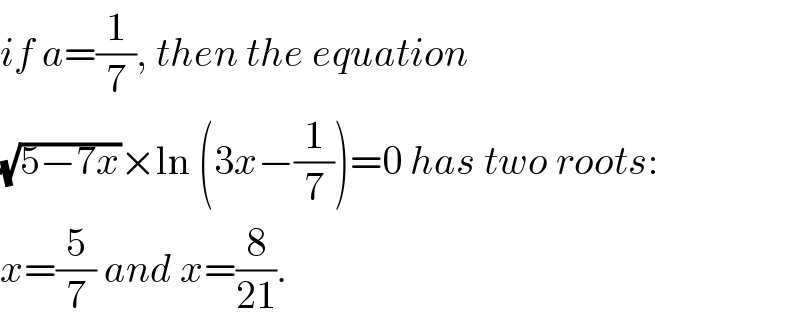
$${if}\:{a}=\frac{\mathrm{1}}{\mathrm{7}},\:{then}\:{the}\:{equation} \\ $$$$\sqrt{\mathrm{5}−\mathrm{7}{x}}×\mathrm{ln}\:\left(\mathrm{3}{x}−\frac{\mathrm{1}}{\mathrm{7}}\right)=\mathrm{0}\:{has}\:{two}\:{roots}: \\ $$$${x}=\frac{\mathrm{5}}{\mathrm{7}}\:{and}\:{x}=\frac{\mathrm{8}}{\mathrm{21}}. \\ $$
Commented by john santu last updated on 26/Jan/20
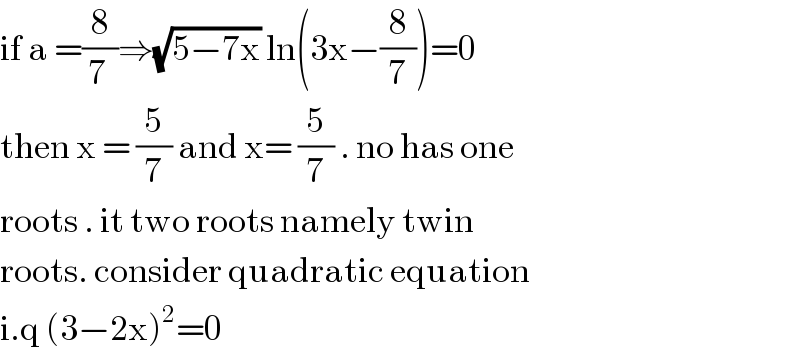
$$\mathrm{if}\:\mathrm{a}\:=\frac{\mathrm{8}}{\mathrm{7}\:}\Rightarrow\sqrt{\mathrm{5}−\mathrm{7x}}\:\mathrm{ln}\left(\mathrm{3x}−\frac{\mathrm{8}}{\mathrm{7}}\right)=\mathrm{0} \\ $$$$\mathrm{then}\:\mathrm{x}\:=\:\frac{\mathrm{5}}{\mathrm{7}}\:\mathrm{and}\:\mathrm{x}=\:\frac{\mathrm{5}}{\mathrm{7}}\:.\:\mathrm{no}\:\mathrm{has}\:\mathrm{one}\: \\ $$$$\mathrm{roots}\:.\:\mathrm{it}\:\mathrm{two}\:\mathrm{roots}\:\mathrm{namely}\:\mathrm{twin} \\ $$$$\mathrm{roots}.\:\mathrm{consider}\:\mathrm{quadratic}\:\mathrm{equation} \\ $$$$\mathrm{i}.\mathrm{q}\:\left(\mathrm{3}−\mathrm{2x}\right)^{\mathrm{2}} =\mathrm{0} \\ $$
Commented by john santu last updated on 26/Jan/20

$$\mathrm{i}\:\mathrm{think}\:\mathrm{the}\:\mathrm{value}\:\mathrm{of}\:\mathrm{ln}\left(\mathrm{3x}−\mathrm{a}\right)\: \\ $$$$\mathrm{not}\:\mathrm{must}\:\mathrm{be}\:=\:\mathrm{0}\:\mathrm{or}\:\mathrm{3x}−\mathrm{a}=\mathrm{1}\:.\:\mathrm{let}\:\mathrm{if}\:\mathrm{3x}−\mathrm{a}=\mathrm{2} \\ $$$$\mathrm{a}=\frac{\mathrm{15}}{\mathrm{7}}−\mathrm{2}=\:\frac{\mathrm{1}}{\mathrm{7}} \\ $$
Commented by mr W last updated on 26/Jan/20
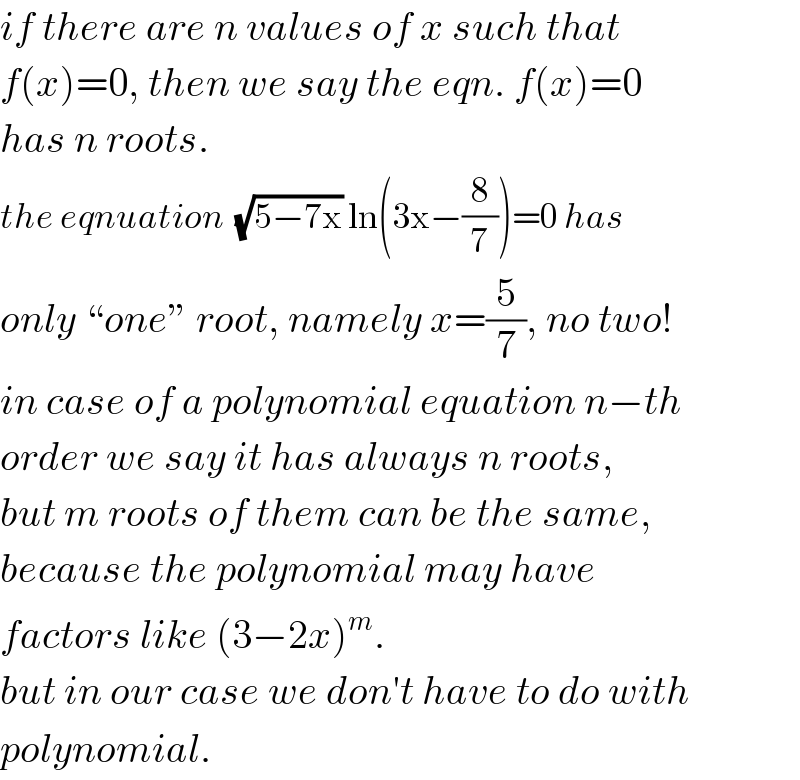
$${if}\:{there}\:{are}\:{n}\:{values}\:{of}\:{x}\:{such}\:{that} \\ $$$${f}\left({x}\right)=\mathrm{0},\:{then}\:{we}\:{say}\:{the}\:{eqn}.\:{f}\left({x}\right)=\mathrm{0} \\ $$$${has}\:{n}\:{roots}. \\ $$$${the}\:{eqnuation}\:\:\sqrt{\mathrm{5}−\mathrm{7x}}\:\mathrm{ln}\left(\mathrm{3x}−\frac{\mathrm{8}}{\mathrm{7}}\right)=\mathrm{0}\:{has} \\ $$$${only}\:``{one}''\:{root},\:{namely}\:{x}=\frac{\mathrm{5}}{\mathrm{7}},\:{no}\:{two}! \\ $$$${in}\:{case}\:{of}\:{a}\:{polynomial}\:{equation}\:{n}−{th} \\ $$$${order}\:{we}\:{say}\:{it}\:{has}\:{always}\:{n}\:{roots}, \\ $$$${but}\:{m}\:{roots}\:{of}\:{them}\:{can}\:{be}\:{the}\:{same}, \\ $$$${because}\:{the}\:{polynomial}\:{may}\:{have} \\ $$$${factors}\:{like}\:\left(\mathrm{3}−\mathrm{2}{x}\right)^{{m}} . \\ $$$${but}\:{in}\:{our}\:{case}\:{we}\:{don}'{t}\:{have}\:{to}\:{do}\:{with} \\ $$$${polynomial}. \\ $$
Commented by mr W last updated on 26/Jan/20
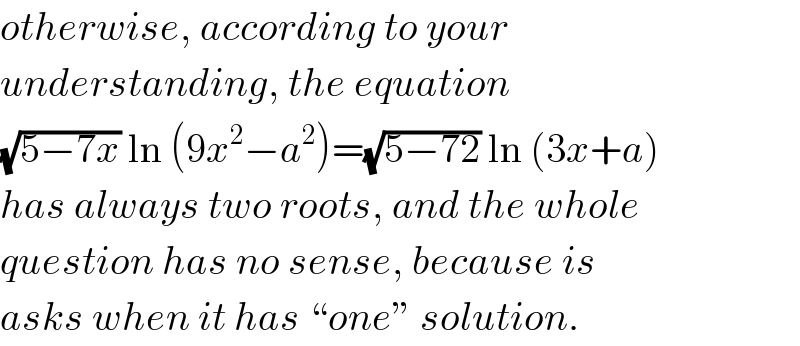
$${otherwise},\:{according}\:{to}\:{your} \\ $$$${understanding},\:{the}\:{equation} \\ $$$$\sqrt{\mathrm{5}−\mathrm{7}{x}}\:\mathrm{ln}\:\left(\mathrm{9}{x}^{\mathrm{2}} −{a}^{\mathrm{2}} \right)=\sqrt{\mathrm{5}−\mathrm{72}}\:\mathrm{ln}\:\left(\mathrm{3}{x}+{a}\right) \\ $$$${has}\:{always}\:{two}\:{roots},\:{and}\:{the}\:{whole} \\ $$$${question}\:{has}\:{no}\:{sense},\:{because}\:{is} \\ $$$${asks}\:{when}\:{it}\:{has}\:``{one}''\:{solution}. \\ $$
Commented by john santu last updated on 26/Jan/20

$$\mathrm{ha}\:\mathrm{ha}\:\mathrm{not}\:\mathrm{all},\:\mathrm{it}\:\mathrm{one}\:\mathrm{solution}\:\mathrm{3x}−\mathrm{2}=\mathrm{0} \\ $$$$\mathrm{namely}\:\mathrm{x}=\:\frac{\mathrm{2}}{\mathrm{3}} \\ $$
Commented by john santu last updated on 26/Jan/20

$$\mathrm{ok}\:\mathrm{deal}\:\mathrm{a}\:=\:\frac{\mathrm{8}}{\mathrm{7}} \\ $$
Commented by john santu last updated on 26/Jan/20

$$\mathrm{means}\:\mathrm{this}\:\mathrm{equation}\: \\ $$$$\left(\mathrm{x}−\mathrm{2}\right)\left(\mathrm{3}^{\mathrm{x}} −\mathrm{9}\right)=\mathrm{0}\:\mathrm{also}\:\mathrm{has}\:\mathrm{one}\: \\ $$$$\mathrm{solution} \\ $$
Commented by mr W last updated on 26/Jan/20

$${yes},\:{namely}\:{x}=\mathrm{2}. \\ $$
